NPB101: Membrane Potentials Part 3
1/68
Earn XP
Description and Tags
Graded Potentials & Action Potentials
Name | Mastery | Learn | Test | Matching | Spaced |
|---|
No study sessions yet.
69 Terms
What is a Graded Potential?
A graded potential is a change in membrane potential
What is an Action Potential?
An action potential is a specific change
Are Action Potentials (APs) traveling?
No APs are regenerating not traveling
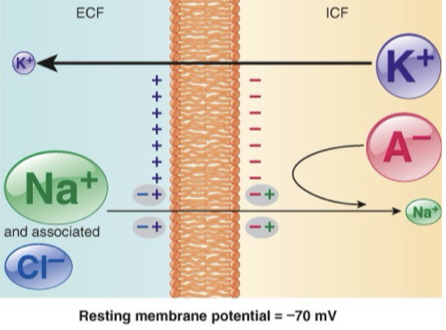
So if the interior is attracting Na+ ions bc its (-) inside, which direction is the electrical force acting on Na+, is it attracting it into the cell or out of the cell?
The electrical force is attracting Na+ into the cell: the ICF is negatively charged (-70mV at resting membrane potential) so because Na+ is positive it is attracted to the negative charge inside the cell
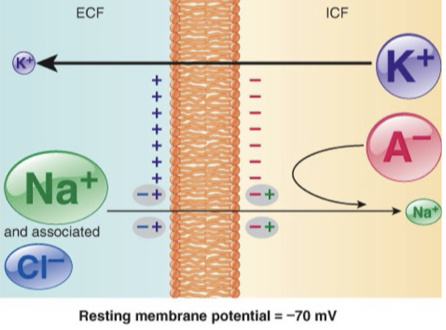
Is the Concentration force going to push Na+ into the cell or push it out of the cell?
The Concentration force is going to push Na+ into the cell: there is a higher concentration of Na+ outside the cell (ECF) compared to the inside
Depolarization is when the ___ becomes more electro____.
cell, electropositive
Hyperpolarization is when the ___ becomes more electro____.
cell, electronegative
A Graded Potential is a ____ in membrane _____.
change, potential
A Threshold is a Em, when we ___polarize to threshold, we get an ___ potential
Em (membrane potential); depolarize, action
Pick an Answer: A Graded Potential is a (small/big) ____ change in the Em so in other words, going away from the resting membrane potential (Erest)
small
T/F: If you have a “small” stimulus would that make the graded potential tiny?
True, because remember, a graded potential is a change in membrane potential, so if you have a small stimulus the graded potential would be tiny and therefore give a change in the membrane (depolarization)

T/F: A graded Potential will be caused by something inducing it?
True because if there is a change in the membrane that has to be caused by something, that something is inducing a graded potential, that something is called a Stimuli
Special graded potentials that occur in sensory neurons are called?
Receptor potential
If a graded potential occurs within the relationship between two neurons its a?
Post Synaptic Potential

T/F: A graded Potential occurs in spots where you dont induce a stimuli
False, a graded potential only occurs in spots where you induce it (localize)
T/F: The size of a graded potential is going to be dependent on how much neurotransmitters will be released or how strongly that stimulus is being applied
True, the size of a graded potential is directly proportional to the strength of the stimulus that initiates it
T/F: A graded potential goes on and on?
False, a graded potential will die out over distance like a wave because it spreads passively as an electrical current, meaning the change in membrane potential spreads along the neuron membrane without requiring any active mechanisms like those used in action potentials.
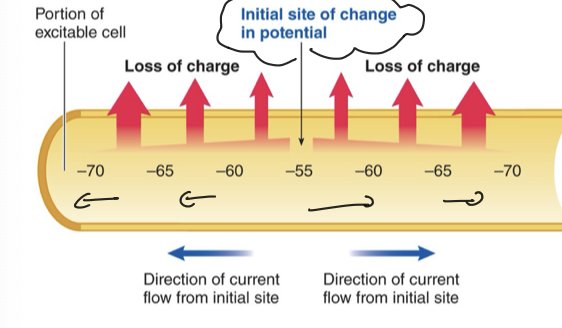
T/F: You want to use a graded potential to transmit a current?
False, you want to use an Action Potential
An Action Potential is a very ___ type of change in the Erest
specific
T/F: A neuron is part of a type of communicative tissue in our body?
True, a neuron is an excitable cell, it can have APs
T/F: A graded potential is greater than an AP
False, an AP is greater than a Graded Potential
T/F: An Action Potential is a stereotyped transient change in the membrane potential
True, because once an AP occurs it’ll always look the same
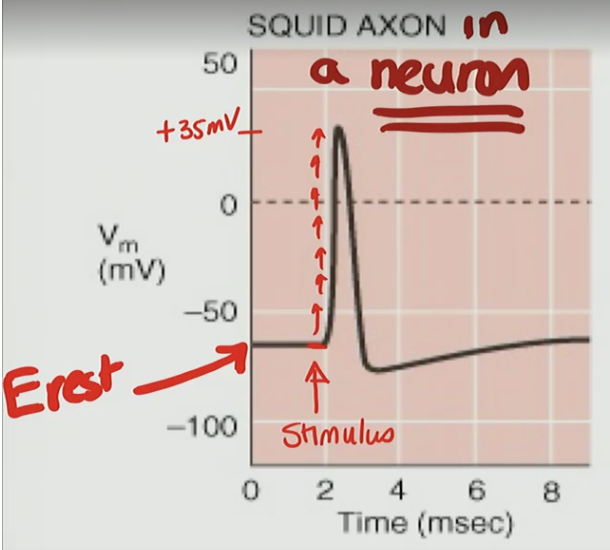
T/F: An action potential drives electrical current
True, action potentials drive electrical current
T/F: Repolarization is a special type of Depolarization
False, Repolarization is a special type of Hyperpolarization
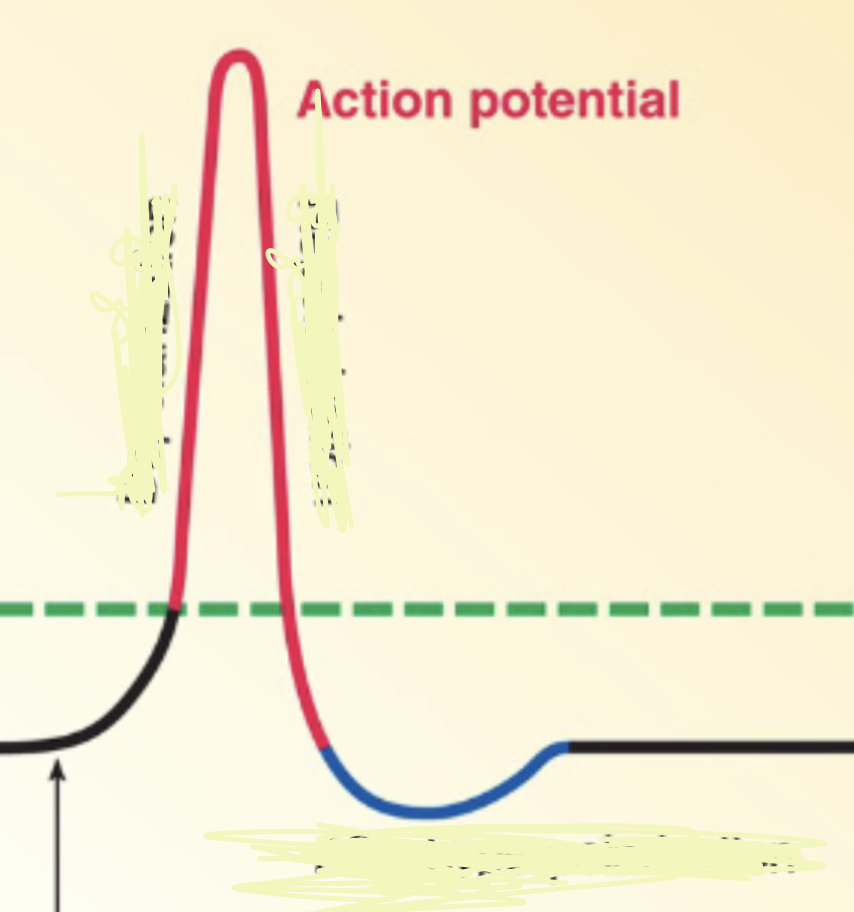
In the blue what is this called? When does it occur? What happens after an (the name of this blue line)?
In the blue this is called an overshoot and occurs after hyperpolarization before it returns back to Em
AP is caused by ____ flow
ion
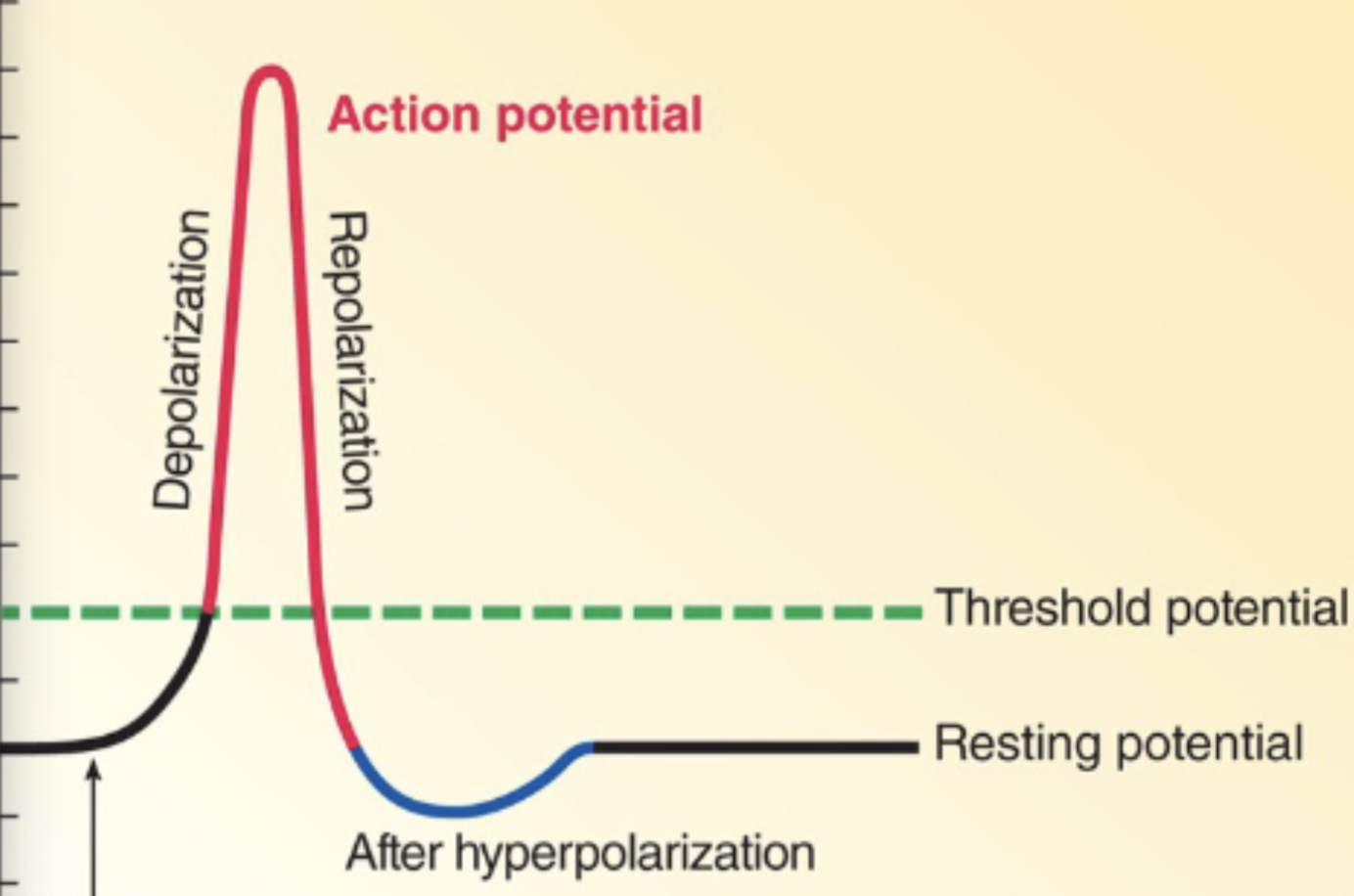
What is occuring here with ions?
Due to the concentration and electrical force Na+ is flowing in causing a depolarization, but if we recall K+ is more permeable when at rest(bc it has more open potassium channels, w/K+ flowing out easily than Na+ can flow in), so this means we had to activate a special channel~ Voltage-gated Na+ channel
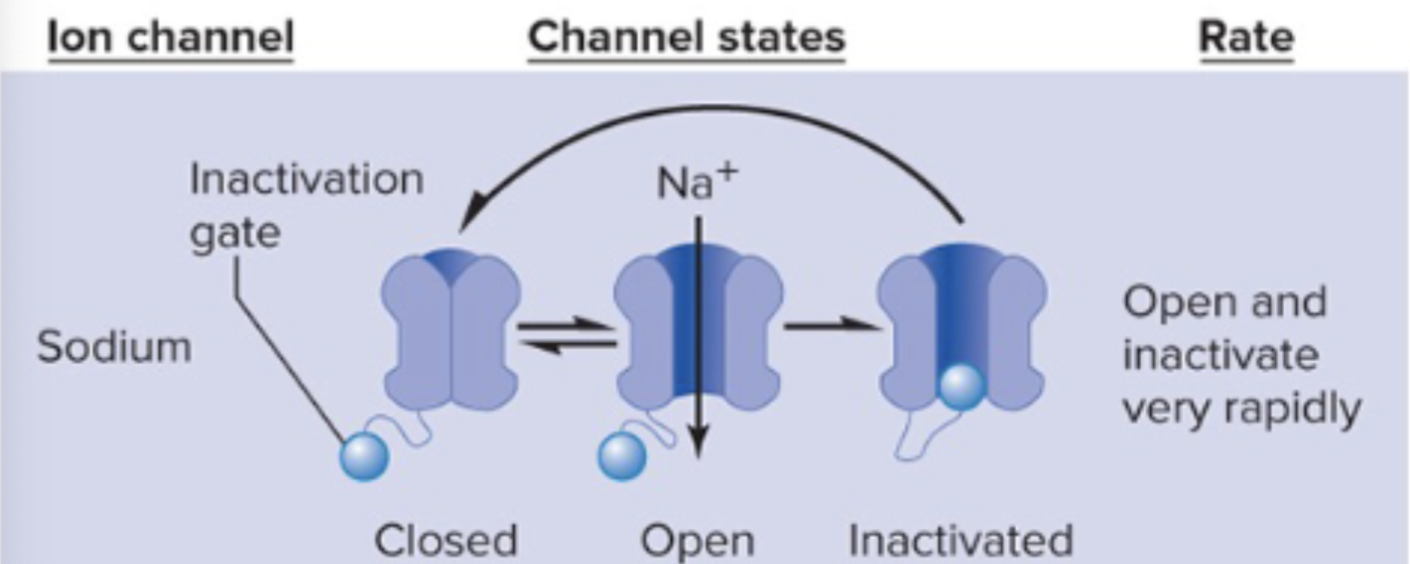
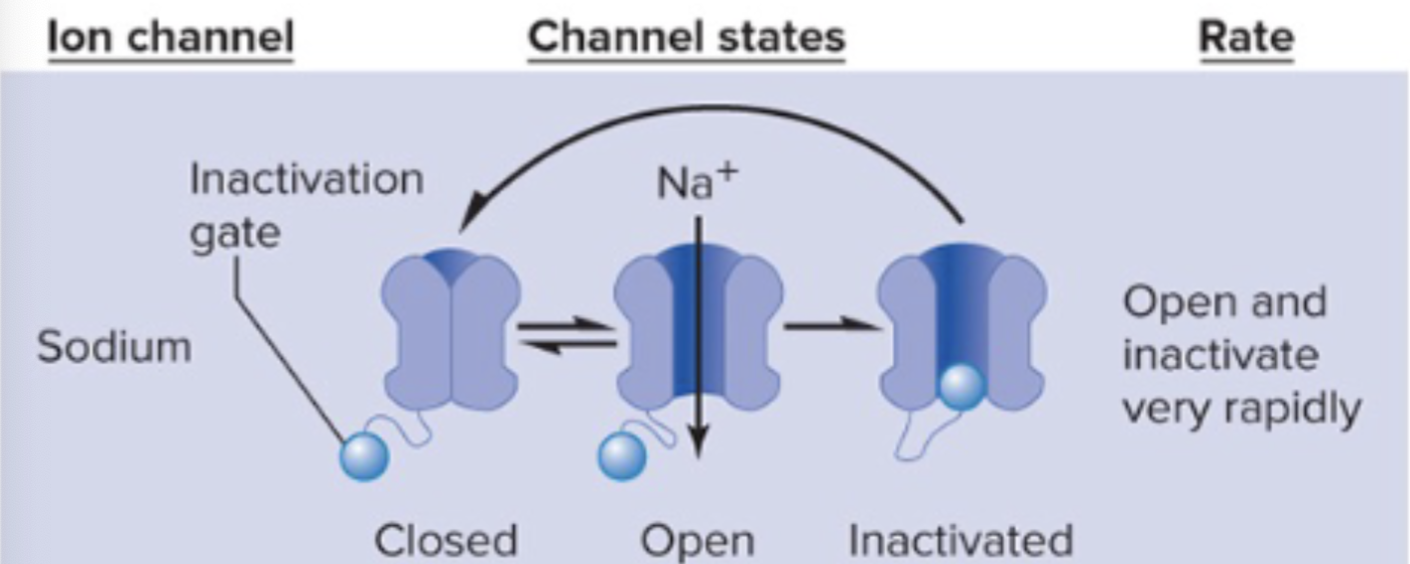
This is a ____ feedback loop
positive
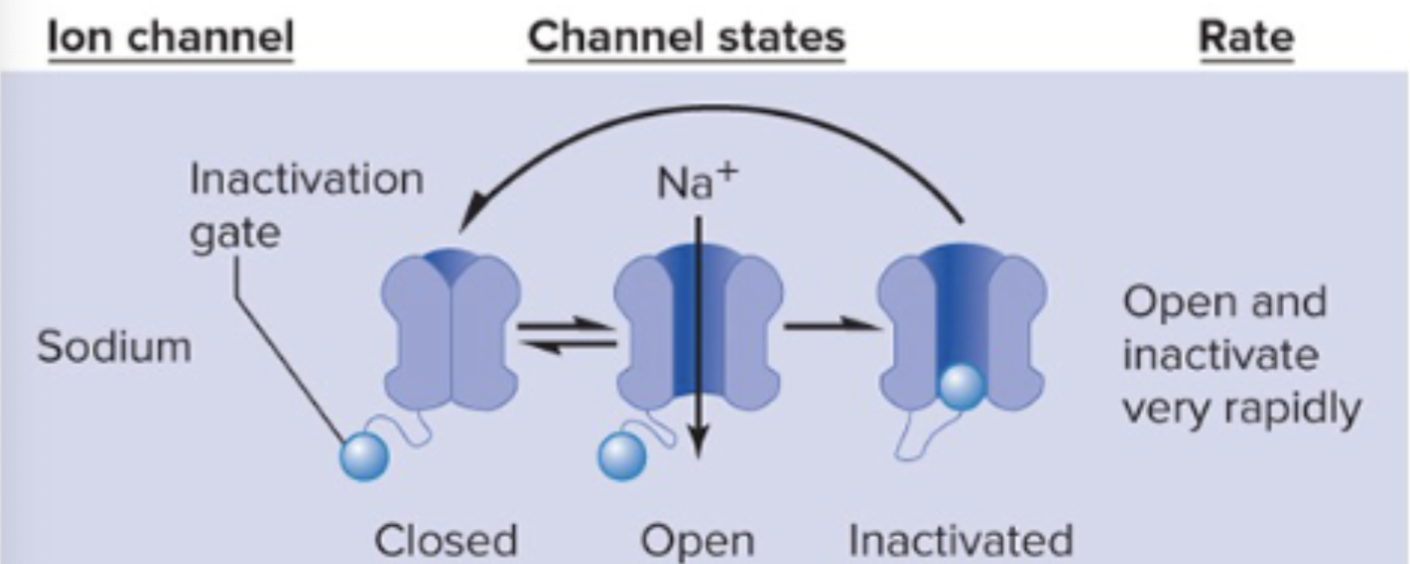
Why is a Voltage-Gated Na+ channel a positive feedback loop?
a Voltage-Gated Na+ channel is a positive feedback loop because as Na+ flows in as in influx due to the concentration gradient and electrical current it depolarizes the cell. This depolarization then causes more voltage-gated Na+ channels to open, creating a self-reinforcing cycle that can lead to an action potential.
Stereotype
Once AP occurs, it’ll always look the same

Transient
not long lasting
Transient nature of an Action Potential
Curves fast when you elicit a stimulus, but then returns back to the resting membrane potential
During the Na+ Voltage gated channel, when it’s at rest, does Na+ ions flow in?
No, because at rest the Na+ voltage gated channel will be closed, allowing nothing to flow in
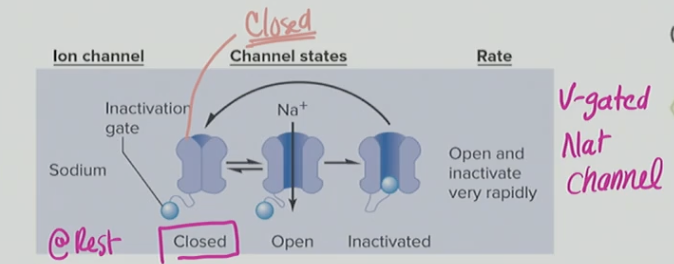
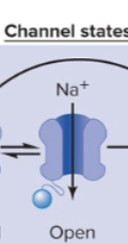
What causes the Voltage Gated Na+ Channel to open?
A voltage allows the Voltage Gated Na+ Channel to open
Depolarization→is membrane potential becoming more neg or pos
membrane potential is becoming more positive
when depolarization occurs at threshold
it activates V-Gated Na+ channel and when it opens up enough, you get that specific depolarization that you see in an action potential
In response to a V-Gated Na+ channel opening, what occurs?
This gate opens in response to passing the threshold with depolarization, then causing a rapid influx of Na+ ions which are positively charged and a depolarization occurs when the membrane potential becomes more positive
Membrane potential
the electrical potential difference across a cell's membrane (remember electrical potential is the force of + ions going to the more - side), caused by a difference in the distribution of ions (charged particles) inside and outside the cell
If you depolarize a cell to threshold what occurs?
An Action Potential
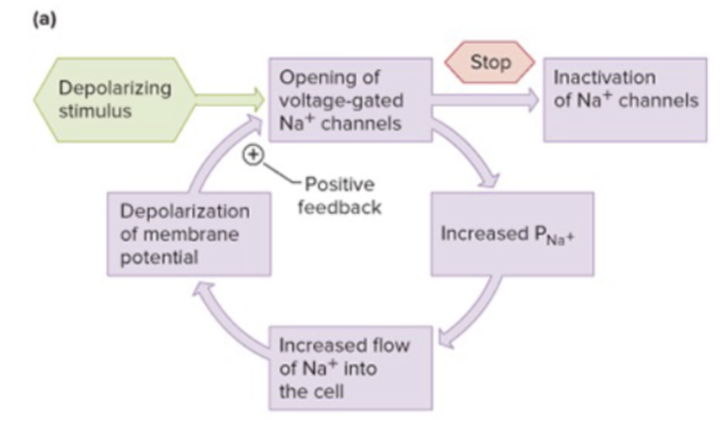
Explain the Positive Feedback Loop
So with the opening of V-gated Na+ channels as the Na+ channels open, this increases permeability and because there’s an increase in permeability that means there’s gonna be an increase in Na+ into the cell because it’s allowing it to flow because it’s flowing through those Na+ channels, then a depolarization of the membrane potential occurs because more Na+ equals depolarization as it withpases the threshold of the membrane potential, the membrane potential is charge of positive charges, which then depolarizing the stimulus opening the voltage gated channels. It’s going over and over.
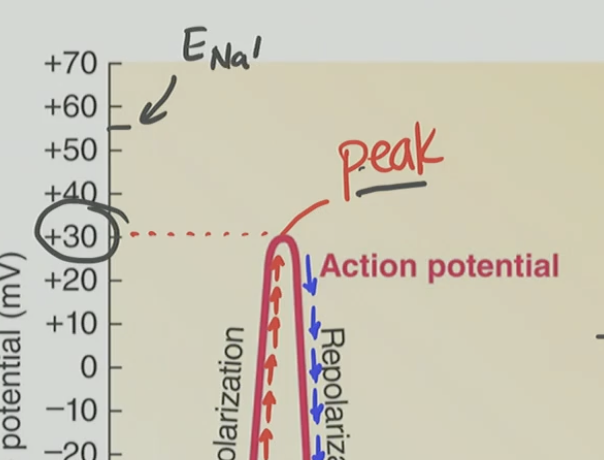
Why is the peak below the equilibrium potential?
so the peak of the action potential is below the equilibrium potential because the inactivation gate (the blue ball) is at rest not allowing Na+ to flow in so when it starts depolarizing the inactivation gate slowly blocks the channel pore causing the inactivated state and Na+ can no longer flow in
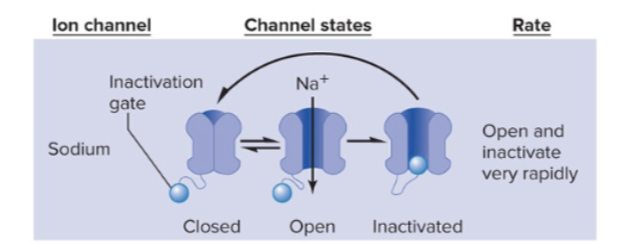
How does the positive feedback loop of the V-gated Na+ channel stop?
It stops with the inactivation gate
What would happen if the positive feedback loop of the V-gated Na+ channel never stopped?
it would depolarize and depolarize and depolarize and it would overshoot and hit the equilibrium potential
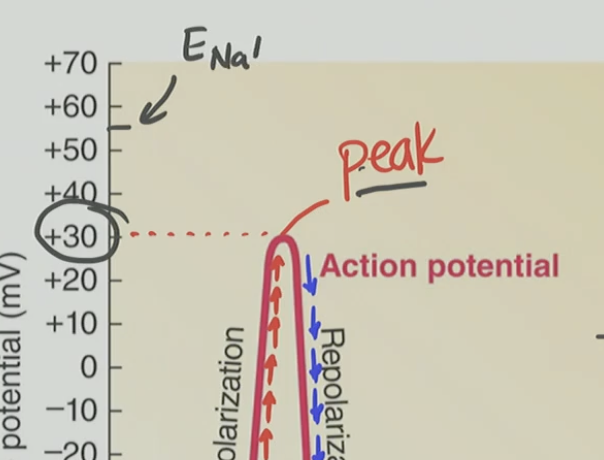
T/F: Does the peak of the action potential cause the inactivation state?
FALSE, The peak is the result of the channel entering the inactivation state.
At first, during depolarization, Na⁺ flows through the voltage-gated sodium channel because the activation gate is openand the inactivation gate is still "resting" — meaning it’s not blocking the pore.
As Na⁺ keeps flowing in and the membrane becomes more and more positive, the inactivation gate slowly begins to close, kind of like a delayed response.
By the time we reach the peak of the action potential, the inactivation gate has now fully blocked the pore, stopping Na⁺ influx. That’s what causes the inactivated state — and that’s why the peak is the result of entering inactivation, not the other way around.
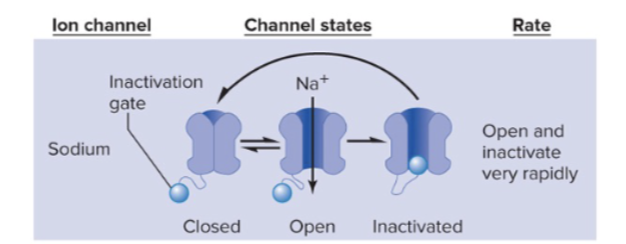
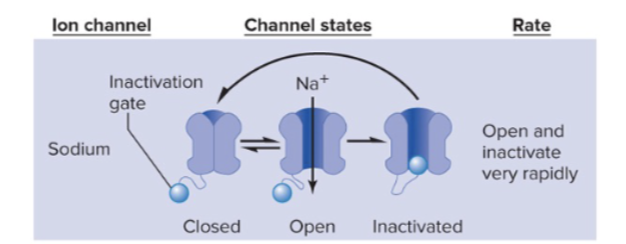
How does the V-Gated Na+ channel go back to the “open” state?
The inactivation gate slowly leaves the channel pore as the membrane repolarizes and returns to the resting potential.
At this point, the activation gate is closed, and the inactivation gate is no longer blocking the pore — this puts the channel back into its "closed but ready to open" state.

Whats causing Repolarization?
During the repolarization state, which is a type of hyperpolarization, there is a lot of potassium inside the cell, but as it flows down the concentration gradient, the inside of the cell is going to be more electronegative compared to the outside as potassium flows out
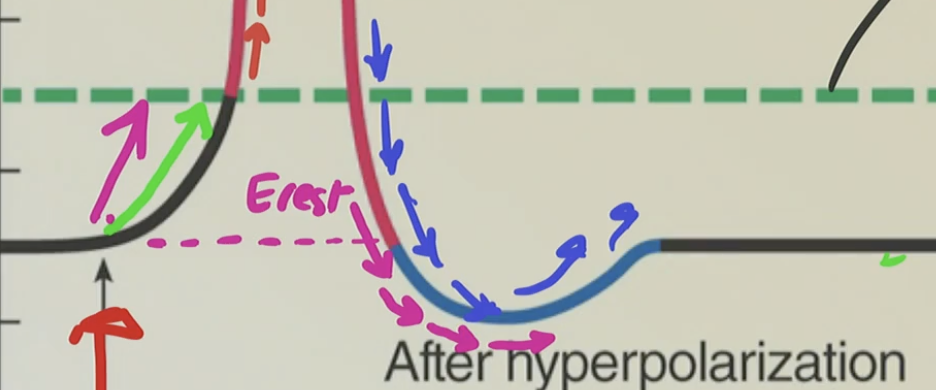
Why does overshooting occur?
Overshooting occurs because the K+ V-Gated Channel closes so slowly that there is K+ still going out causing the action potential to overshoot the resting membrane potential, but then it closes some more of those K+ channels and recovers
T/F: A K+ channel opens fast and closes slowly.
False, a K+ channel opens and closes slowly

T/F: Na+ and K+ channel close slowly
False Na+ closes fast and K+ closes slow
T/F: V-Gated Na+ channel has 1 gate
False, it has two gates: activation gate and inactivation gate

T/F: When the cell is at resting potential the activation gate it CLOSED
True
T/F: When the cell is depolarizing the activation gate it CLOSED
False, the gate is starting to OPEN rapidly while the INACTIVATION gate is starting to close slowly, and the Inactivation is occurring rapidly

Whats the point of an action potential?
To drive an Electrical current
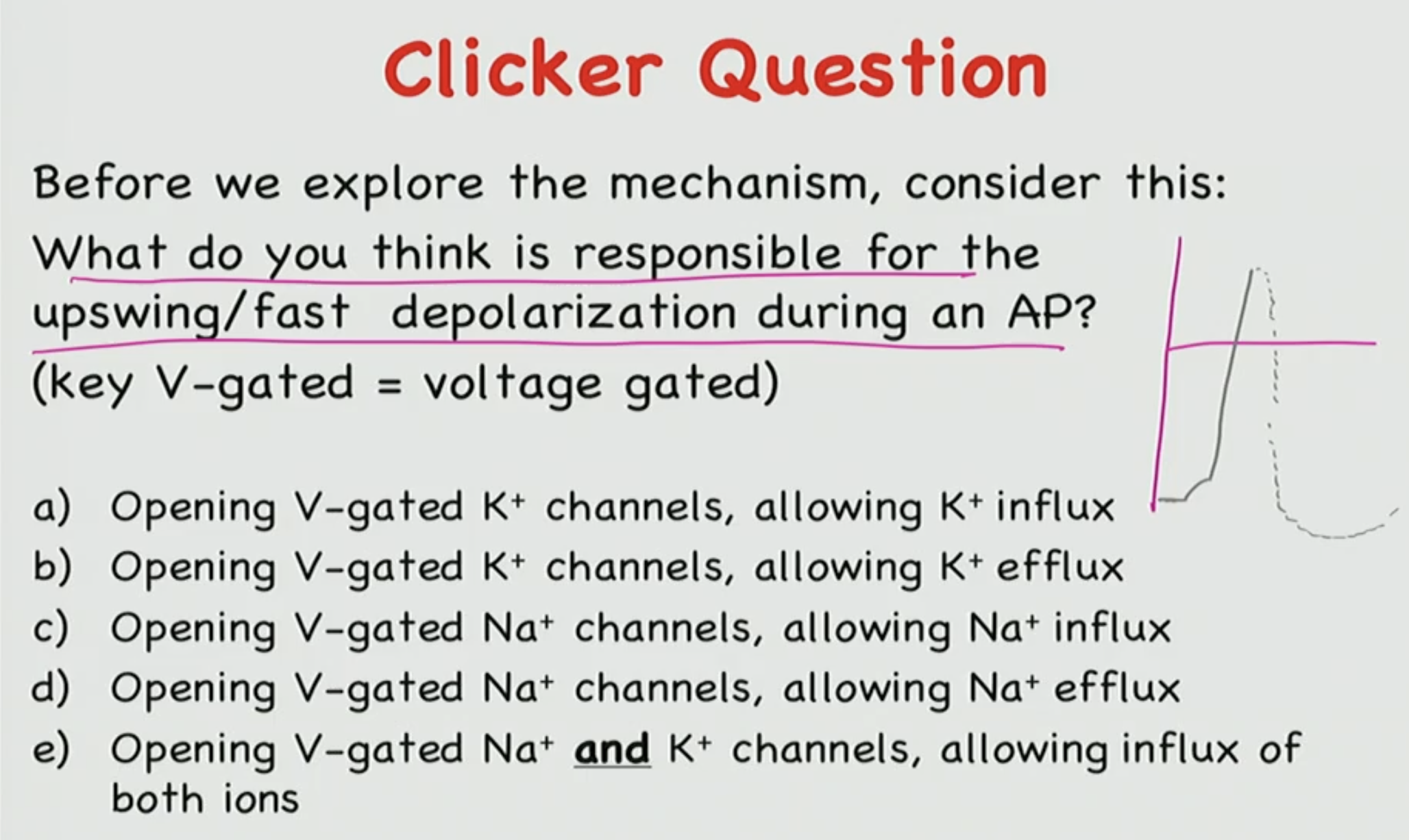
Which is the correct answer? Explain.
C. because Na+ channel is responsible for depolarization as a fast influx of Na+ creates depolarization

A rapid depolarization is usually due to an influx of ___.
Na+
At threshold we (open/close)____ enough V-Gated (Na+/K+)____ channels to cause rapid (de/re/polarization)____.
open, Na+, depolarization
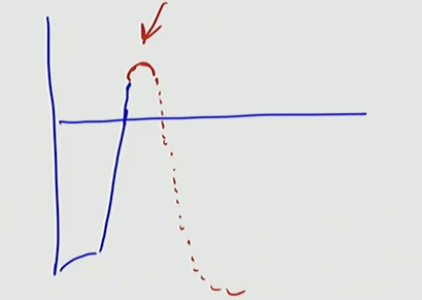
What’s occuring here?
As the cell depolarizes, at the peak inactivation gates are closing the channel pore = “inactivation state”
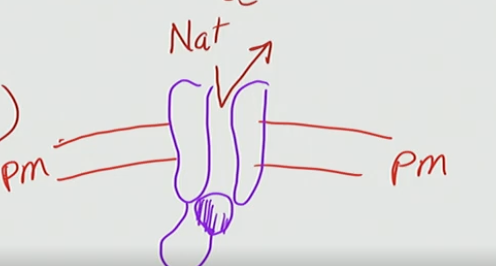
At rest the ___ channel is closed
K+
T/F: Depolarization activates rapidly with the K+ channel
False, it activates slowly
T/F: a Membrane depolarized to threshold due to a stimulus
True

T/F: The closure of the V-Gated K+ channel helps return the membrane potential to the resting value.
True the closure of the V-Gated K+ channel does result in the return of going to the resting potential because after the depolarization and repolarization and overshoot it goes to resting potential
Absolute Refractory Period
a period of time in which if I try to stimulate the neuron again after I first cause the action potential, I don't get an action potential, I'm trying to hit it with a stimulus. Nope, nothing's happening.
That's the absolute refractory period.
During the Absolute Refractory Period is Na+ channel open or closed?
The Na+ channel is in the inactivation state because Absolute Refractory Period doesn’t allow it to reopen yet since Na+ has to close to reopen and its just stuck in the inactivation state until it returns to closed state
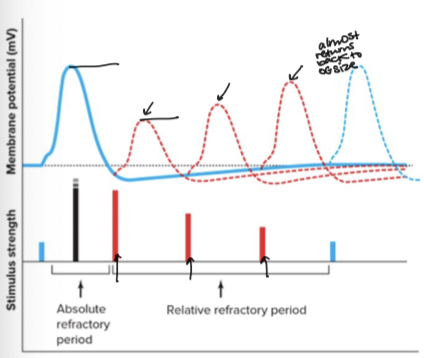
Relative Refractory Period
elicits/gets an AP
How does Relative Refractory Period elicit an AP
Relative Refractory Period elicit an AP because the V-Gated Na+ channels converted to a closed state which means it can then open to allow AP to occur again
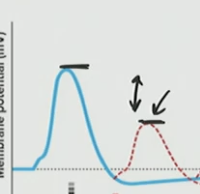
whats causing this height difference?
V-Gated K+ channels are still open causing hyperpolarization making it more electronegative and the Na+ channel being open trying to depolarize and be electropositive while K+ repolarizing causes this and they are fighting eachother causing small AP
An AP occurs when PSPs (graded potential) sum and drive the membrane potential past ___.
threshold
The upswing of the AP is due to ______ ion that moves ________.
Na+ influx, Na+ into the cell
Repolarization is due to ________.
K+ efflux moving K+ out of the cell